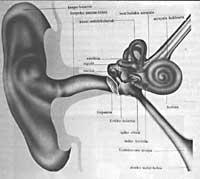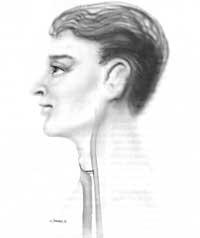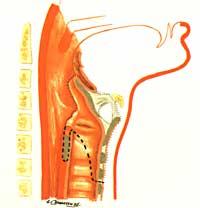Ear, nose and throat: unified threesome
1990/03/01 Aizpurua Sarasola, Joxerra | Benavides, Juan Karlos Iturria: Elhuyar aldizkaria
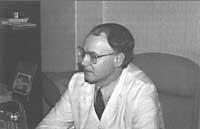
Elh. : What is otolaryngology and why does this specialty collect so different ear, nose and throat?
J.A. : Otolaryngology and ophthalmology are the oldest specialties known. According to the old writings that have reached us to this day, they are prior to the time of the Egyptians. For a long time the two specialties have been one and right now in the US they continue to do so. In the rest, each specialty has followed its path. The pathology, physiology and anatomy of the ears, nose, larynx, pharynx, neck, trachea and bronchi are studied within the otolaryngology. The joint analysis of so many organs is due to the historical evolution of the specialty. As in the past ophthalmology was differentiated, in otolaryngology several sections are being differentiated. Today, for example, find otologists, laryngologists, etc. is getting easier. However, the union of the nose and ear with the eustachian tube and the direct connection of the nose and throat, give unity to the specialty.
Elh. : Therefore, can a greater number of otologists and laryngologists lead to the separation of specialty?
J.A. : Yes, of course. Technical advances are expanding the areas of work and the deep knowledge of all of them is increasingly difficult. We have to go towards specialization, which makes it essential to reduce the areas of work.
Elh. : What are the most common diseases in otolaryngology in Euskal Herria?
J.A. : Otolaryngology has been one of the most advanced medical specialties in recent years. The evolution of chemotherapy, anti-inflammatory drugs and antibiotics has caused a change in the treatment of diseases. Therefore, they have created each other have disappeared. While syphilis, diphtheria, tuberculosis and leprosy are practically disappeared, AIDS is increasing in the Basque Country. In our specialty, laryngeal cancer has grown the most, especially in men. Although the number of women smokers has increased greatly, laryngeal cancer has not grown to the same extent. There seems to be a defensive hormonal mechanism.
Elh. : Therefore, laryngeal cancer is related to being a smoker.
J.A. : There have been numerous statistics and at least 90% of laryngeal cancers come from smokers. This does not mean that the responsibility for cancer is exclusively tobacco. We know that tobacco tars cause cancer, as animal trials have been conducted. The vocal cords have a very small epithelium and if the tars touch constantly they can cause laryngeal cancer.
Elh. : What is the resolution of hearing problems?
J.A. : The ear is the greatest advance of the branches of our specialty. In the field of research, difficult to detect organs are included. They work because there are still many gaps in auditory physiology. In the field of prosthesis much progress has been made in recent years, especially in transmission deafness, that is, in the middle ear. In the eardrum or in the inner ossicles, the composition with own bones or ceramics is giving very good results. I want to use the patient's bones, the cheapest and the least chances of rejection. On the other hand, the results obtained through prosthesis without cuts are very good not only in transmission hearing loss, but also in neurosensory.
Elh. : But prostheses are not so socially accepted, aren't they?
J.A. : Yes, it costs a lot to mentalize the patient. It is just a psychological problem, because wearing glasses is carrying a prosthesis, but that does not generate problems.
Elh. : There is great hope in the technique of implementing cocles. What is it?
J.A. : In the coke, in the inner ear, one or more electrodes are placed. Therefore, what the patient hears is not the voice, but the sound of the metal. Therefore, for patients who have never heard it, this type of cut does not make much sense, as they would hear meaningless sounds. On the contrary, those who have ever heard have more possibilities, but have to start a hard process of innovation.
This technique is not current but 30 years ago. I think this technique still has some mistakes, but I think it has a very good future. Therefore, within five or ten years this technique can have much more possibilities.
Elh. : Is it true that some medicines used to cure some diseases can damage the ear?
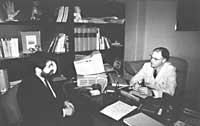
J.A. : Yes, it is true. Some medicines, such as antibiotics, anti-inflammatory drugs, and analgesics, can cause irreversible damage, as they make neurosensory cells in the inner ear sick.
Elh. : Moving to the other section of the specialty, how have larynx or throat problems evolved?
J.A. : Larynx cutting has advanced a lot in recent years. What once seemed crazy, today most specialists do. First total laryngectomies were made and patients died due to lack of drugs or means. Later the cordectomies were performed. It is the most practiced surgery at the beginning of this century. But the most important issue in laryngology is the recovery of the voice of the patient who has suffered a laryngeal cut. Patients who until recently had their larynx removed lost their voice and got what is called an esophageal voice. Approximately 50-60% of patients achieved esophageal voice.
Another 40% did not access this type of voice. They used a monotonous, metallic and low-intensity electronic voice larynx. From 1979 onwards, fistulas between the trachea and the esophagus were developed. Since then new techniques have been created. In 1981 we started a technique that we are currently developing. In one of the following specimens this technique will be detailed. Congresses and symposiums are held annually on this subject. A group of experts from eight states have been formed in this area and I am the only representative of the state.
Elh. : Should everyone affected by the cut have a hole or tracheostomy?
J.A. : We try to leave the tracheostoma aside, but if the larynx is completely removed, so that the patient can breathe there is no other way than tracheostomy. Why not a laryngeal transplant? But we have a little this question. However, thanks to early diagnosis, total laryngectomies are avoided and they become more partial.
Elh. : Is prosthesis implantation normal in Euskal Herria?
J.A. : Although prostheses are placed in the capitals of Euskal Herria, they are not done as much as in Donostia. Prostheses are pieces of silicone. They last for 4 months and their cleaning is fortnightly. The prosthesis we use is cheaper than the imported one, since it is manufactured in Gipuzkoa.
Elh. : And the nose what?
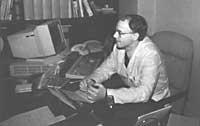
J.A. : The nose has been considered one of the poorest parts of the specialty. Until recently only the anterior part of the nose could be seen through the rhinoscope. Today, however, through flexible fibroscopes, fiber optic fibroscopes and rigid tube endoscopes of different sizes, we can reach any point of the nose and this of yesteryear.
Elh. : Does Zurrunga have any repairs?
J.A. : Snoring is done by those who have a large soft roof of mouth. When they are asleep, that is, when the person is calm, the soft palate is hanging without tension and begins to vibrate when the air enters. To avoid this it is necessary to remove the excess part of the soft palate and stretch the adjacent tissues. The cut is very simple and although in medicine there are not 100% figures, almost all people who have suffered the cut stop snoring.
Elh. : This last question has become essential in all our interviews. Does your specialty use new technologies?
J.A. : I think the answer will also be essential. Our specialty is in the hands of scientific advances. We mentioned fiber optic fibroscope, but in surgery laser and MRI detection have given a great boost to our specialty. We can say, therefore, that “depending on the technological advances, the evolution of the specialty”.
Elh. : Thank you very much.

Gai honi buruzko eduki gehiago
Elhuyarrek garatutako teknologia



